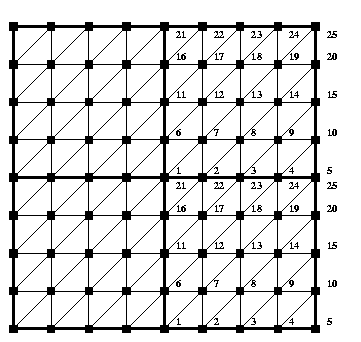


Next: 6 Iterative Solvers
Up: Course on Parallelization
Previous: 4 Global Operations
Let the unit square [0, 1]2 be partitioned uniformly
into
procx x procy rectangles  numbered
row by row.
The numbering of the subdomains coincides with the
corresponding process-id's (ranks).
numbered
row by row.
The numbering of the subdomains coincides with the
corresponding process-id's (ranks).
The function
from example/accuc
(example/accuf)
generates the topological relations
corresponding
to the domain decomposition defined above. These
information are stored in the integer array neigh(4).
A check-board coloring is defined in color.
Moreover, the function
can be used to generate the coordinates of the lower left
corner (xl, yb) and the upper right corner (xr, yt) of each subdomain.
-

- Realize a local data exchange of a double precision number
between each processor and all of it's neighbors
(connected by a common edge).
Use the routine
ExchangeD
from E8.
Let each subdomain  be uniformly discretized
into
nx * ny rectangles generating a triangular mesh
(nx, ny are the same for all subdomains !).
be uniformly discretized
into
nx * ny rectangles generating a triangular mesh
(nx, ny are the same for all subdomains !).

If we use linear f.e. test functions then
each vertex the triangles represents one component of
the solution vector, e.g., the temperatur in this point,
and we have
nd : = (nx + 1) * (ny + 1) local unknowns
within one subdomain.
We propose a locally rowise ordering of the unknowns.
Note, that the global number of unknowns is
N = (procx*nx + 1) * (procy*ny + 1) < procx*procy*nd ) .
copies the values
of w corresponding to the boundary South(id=1), East (id=2),
North (id=3), West (id=4) into the auxiliary vector s.
Vice versa, the function
adds
the values of s to the components of w corresponding to the
nodes on the boundary South(id=1), East (id=2),
North (id=3), West (id=4). These functions can be used for
the accumulation (summation) of
values corresponding to the nodes on the interfaces between two
adjacent subdomains which is
a typical and necessary operation.
-

- Write a routine which accumulates a distributed
Double Precision vector w. The call of such a
routine could look
as follows
where w is both in- and output vector.



Next: 6 Iterative Solvers
Up: Course on Parallelization
Previous: 4 Global Operations
Gundolf Haase
2003-05-19
![\begin{figure*}\unitlength0.04\textwidth
\begin{picture}(12,6)
\put(0,0){\line(...
...0,0)[r]{West}}
\put(4.5,2.5){\makebox(0,0)[l]{East}}
\end{picture}\end{figure*}](img24.png)
![\begin{figure*}\unitlength0.04\textwidth
\begin{picture}(12,6)
\put(0,0){\line(...
...0,0)[r]{West}}
\put(4.5,2.5){\makebox(0,0)[l]{East}}
\end{picture}\end{figure*}](img24.png)
![]() be uniformly discretized
into
nx * ny rectangles generating a triangular mesh
(nx, ny are the same for all subdomains !).
be uniformly discretized
into
nx * ny rectangles generating a triangular mesh
(nx, ny are the same for all subdomains !).
